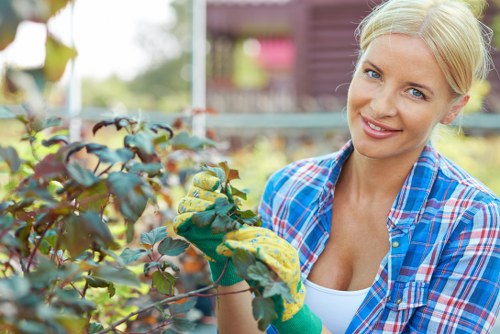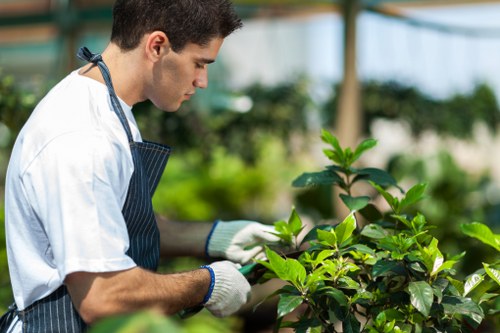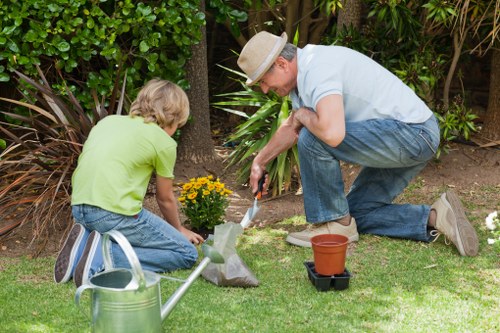Garden Maintenance in Hornsey

Maintaining a garden in Hornsey can be a rewarding endeavor, allowing residents to enjoy a beautiful outdoor space. However, it requires regular care and attention to keep it thriving throughout the seasons.
Whether you're a seasoned gardener or a beginner, understanding the specific needs of your garden is crucial. Hornsey's climate and soil conditions play a significant role in determining the best maintenance practices.
In this comprehensive guide, we will explore essential garden maintenance tips tailored for Hornsey, helping you achieve a lush and vibrant garden all year round.
Understanding Hornsey's Climate

Hornsey experiences a temperate maritime climate, characterized by mild winters and cool summers. This climate is generally favorable for a wide variety of plants, but it also presents specific challenges.
The key to successful garden maintenance in Hornsey is to choose plants that are well-suited to the local climate. This ensures they can thrive with minimal intervention and are resilient against common pests and diseases.
Additionally, understanding the seasonal changes will help you plan your gardening activities more effectively, ensuring your garden remains healthy and vibrant throughout the year.
Soil Preparation and Improvement

Healthy soil is the foundation of a thriving garden. In Hornsey, the soil can vary, so it's essential to test its quality and make necessary amendments.
- Soil Testing: Conduct a soil test to determine pH levels and nutrient content. Hornsey's soil may require adjustments to optimize plant growth.
- Amendments: Incorporate organic matter such as compost or well-rotted manure to improve soil structure and fertility.
- Drainage: Ensure proper drainage to prevent waterlogging, which can harm plant roots.
Regularly improving your soil not only benefits your current garden but also enhances the long-term health of your outdoor space.
Plant Selection and Arrangement

Selecting the right plants is crucial for garden maintenance. Opt for native species and those adapted to Hornsey's climate to reduce the need for extensive care.
Consider the following when choosing plants:
- Sunlight Requirements: Ensure plants receive adequate sunlight based on their specific needs.
- Watering Needs: Group plants with similar watering requirements together to simplify irrigation.
- Growth Habits: Arrange plants according to their height and spread to create a balanced and aesthetically pleasing layout.
A thoughtful arrangement not only enhances the beauty of your garden but also promotes healthy growth by reducing competition for resources.
Regular Maintenance Tasks

Consistent maintenance ensures your garden remains in excellent condition. Key tasks include:
- Weeding: Regularly remove weeds to prevent them from competing with your plants for nutrients and water.
- Pruning: Trim overgrown branches and dead foliage to encourage healthy growth and improve plant shape.
- Watering: Maintain a consistent watering schedule, adjusting for seasonal changes and rainfall.
- Fertilizing: Provide essential nutrients through appropriate fertilizers to support plant health.
By staying on top of these tasks, you can ensure your garden remains vibrant and free from common issues.
Pest and Disease Management
Protecting your garden from pests and diseases is vital for maintaining its health. In Hornsey, common challenges include slugs, aphids, and fungal infections.
Implement an integrated pest management (IPM) approach:
- Monitoring: Regularly inspect plants for signs of pests or disease.
- Prevention: Use barriers, traps, and encourage beneficial insects to naturally control pest populations.
- Treatment: Apply environmentally friendly treatments when necessary, avoiding chemical pesticides that can harm beneficial organisms.
By addressing issues promptly and responsibly, you can maintain a healthy and balanced garden ecosystem.
Seasonal Gardening Tips
Adapting your maintenance routine to the seasons ensures your garden remains resilient against weather changes.
Spring
Spring is the perfect time to prepare your garden for the growing season.
- Planting: Introduce new plants and perennials.
- Soil Preparation: Add compost and mulch to enrich the soil.
- Pruning: Trim shrubs and trees to encourage new growth.
Summer
During summer, focus on maintaining plant health and managing water resources.
- Watering: Ensure adequate moisture, especially during dry spells.
- Weeding: Keep the garden free from invasive weeds.
- Deadheading: Remove spent flowers to promote continuous blooming.
Autumn
Autumn is ideal for preparing your garden for the winter months.
- Leaf Cleanup: Rake fallen leaves to prevent fungal growth.
- Planting Bulbs: Add spring-flowering bulbs to your garden.
- Pruning: Cut back hardy perennials and shrubs.
Winter
In winter, focus on protecting your garden from frost and harsh weather.
- Mulching: Apply mulch to insulate plant roots.
- Tool Maintenance: Clean and store gardening tools properly.
- Planning: Plan your garden layout for the upcoming year.
Utilizing Professional Garden Services
While DIY maintenance is possible, professional garden services can offer expertise and save you time.
Consider hiring professionals for tasks such as:
- Landscape Design: Creating a cohesive and aesthetically pleasing garden layout.
- Tree Care: Expert pruning and management of large trees.
- Seasonal Cleanups: Comprehensive garden maintenance tailored to each season.
Professional services ensure your garden receives the highest level of care, enhancing its beauty and longevity.
Eco-Friendly Gardening Practices
Adopting sustainable practices benefits both your garden and the environment.
Implement eco-friendly methods such as:
- Composting: Recycle organic waste to create nutrient-rich compost.
- Rainwater Harvesting: Collect and utilize rainwater for irrigation.
- Native Plants: Use native species that require less water and are more resistant to local pests.
These practices promote a sustainable garden ecosystem, reducing your environmental footprint.
Common Mistakes to Avoid
Even with the best intentions, gardeners can make mistakes that affect their garden's health.
- Overwatering: Excessive moisture can lead to root rot and attract pests.
- Poor Plant Selection: Choosing plants that are not suited to Hornsey's climate can result in poor growth.
- Neglecting Soil Health: Ignoring soil quality can lead to nutrient deficiencies and weak plants.
- Improper Pruning: Over-pruning or incorrect techniques can damage plants and hinder growth.
Avoiding these common pitfalls ensures a healthier and more resilient garden.
Advanced Gardening Techniques
For those looking to take their garden maintenance to the next level, consider advanced techniques that enhance plant health and garden aesthetics.
Companion Planting
Companion planting involves growing compatible plants together to maximize growth and deter pests.
- Benefits: Improved pollination, pest control, and resource sharing.
- Examples: Planting basil with tomatoes to repel flies and mosquitoes.
Vertical Gardening
Vertical gardening maximizes space by growing plants upwards using trellises, shelves, or walls.
- Advantages: Efficient use of space, easier maintenance, and a unique aesthetic appeal.
- Suitable Plants: Vines, herbs, and compact vegetables.
Hydroponics
Hydroponics is a soil-less gardening method that uses nutrient-rich water to grow plants.
- Pros: Faster growth rates, precise nutrient control, and reduced water usage.
- Considerations: Initial setup costs and the need for regular monitoring.
Incorporating these techniques can significantly enhance your gardening experience and results.
Tools and Equipment for Effective Maintenance
Having the right tools is essential for efficient garden maintenance in Hornsey.
- Pruning Shears: For precise trimming of plants and shrubs.
- Garden Fork: Useful for turning and aerating the soil.
- Watering System: Drip irrigation or soaker hoses to ensure consistent watering.
- Protective Gear: Gloves, knee pads, and appropriate clothing to ensure safety and comfort.
Investing in quality tools not only makes maintenance tasks easier but also contributes to the overall health of your garden.
Creating a Sustainable Garden
Sustainability in gardening involves practices that are environmentally friendly and resource-efficient.
Key aspects include:
- Biodiversity: Incorporate a variety of plants to support a healthy ecosystem.
- Water Conservation: Implement techniques such as mulching and rainwater harvesting.
- Organic Practices: Use organic fertilizers and pest control methods to reduce chemical impact.
A sustainable garden not only benefits the environment but also creates a more resilient and self-sufficient outdoor space.
Conclusion
Garden maintenance in Hornsey requires a combination of knowledge, effort, and the right practices. By understanding the local climate, preparing your soil, selecting appropriate plants, and adhering to regular maintenance tasks, you can cultivate a beautiful and thriving garden.
Embracing sustainable practices and utilizing professional services when needed will further enhance the health and aesthetics of your garden. Remember, a well-maintained garden not only provides a serene environment but also contributes positively to your overall well-being.
Ready to transform your garden? Contact us today or book your service now to get started on creating the garden of your dreams in Hornsey.
